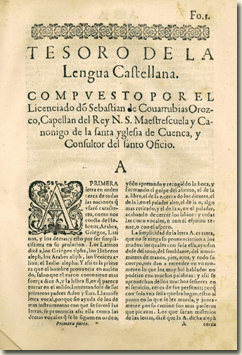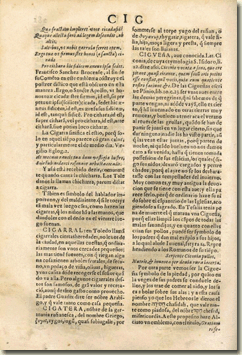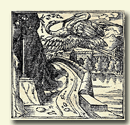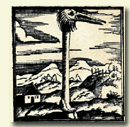|
Sebastián de Covarrubias Horozco:
Tesoro de la lengua castellana o española (1611)
con su Suplemento manuscrito
IN 1726 WHEN the first few
pages of the
Diccionario de Autoridades were being prepared, the
academicians of the Spanish Royal Academy (RAE) already
considered the
Tesoro de la lengua castellana o española by Sebastián de
Covarrubias to be the only lexicographical light available to
guide them. They thus make this affirmation in the “Prologue”
stating that, at that time
“la lengua española, siendo tan rica
y poderosa de palabras y locuciones, quedaba en la mayor
oscuridad [...] sin tener otro recurso que el libro de
Tesoro de la lengua castellana o española,
que sacó a luz el año de 1611 Don Sebastián de Covarrubias”
[the Spanish language, being so rich and powerful in words and
locutions, was left in the greatest obscurity (..) with no other
resource except the book of the Tesoro de la lengua
castellana o española, which Don Sebastián de Covarrubias
brought out in the year 1611].
Those same academics also cautioned
immediately that the Tesoro of Covarrubias was not
exactly a “dictionary” and that its validity as a theoretical
model was limited. Indeed, there is a world of difference
between the Tesoro and the Diccionario de Autoridades
(and modern lexicography). It is not just a question of the
passing of 100 years, nor even the change represented by the
work of a single man to the collaborative effort of a selected
group patronized by an entire Royal Academy. It is also the
partial abandonment of a pre-Enlightenment encyclopedic
mentality converging with many other intellectual initiatives
dating from the beginning of the 17th century (silvas,
miscellanies, polyantheas... or the emblematic work of
Covarrubias himself), that explores the origins of words and
attempts to inquire as well into the moral sense – obviously
transcendental – of the world and of language. Thus, the
Tesoro of Covarrubias has an immense cultural appeal: we
cannot read it as a mere repertory of Spanish words that are
defined, commented, studied in terms of their etymology and
interconnected, but rather as a literary monument that appears
exactly at the midpoint of the Spanish Golden Age, the work of a
man from the same generation as Miguel de Cervantes.
In spite of the unanimous acclaim, almost
from the moment of its publication, of the numerous virtues of the
Tesoro, its editorial fate has been impoverished. The
princeps of 1611 is obviously incomplete and Covarrubias died in 1613, leaving behind a Suplemento
that he had prepared for publication in manuscript form. In
1674, Benito Remigio Noydens published a second edition – divided
into two parts preceded by Bernardo Alderete’s (or Aldrete)
Del origen y principio de la lengua castellana –, in which he
adds his own additional entries but ignores the Suplemento.
From that point on, the Tesoro does not issue from the
presses again until the 1943 edition by Martí de Riquer.
Misfortune also doomed two early attempts at continuing and
completing the work of Covarrubias to failure, those of Father
Pablo Cenedo (Nuevo tesoro de la lengua castellana) and
Juan Francisco Ayala Manrique (Tesoro de la lengua castellana),
with the former lost and the latter incomplete. Nevertheless,
the Tesoro’s deserved reputation as
a lively and
influential work is proven by its clear influence on several
bilingual European dictionaries of the 17th and 18th centuries
(Cesar Oudin, Lorenzo Franciosini, John Minsheu, John
Stevens...). Its influence is especially evident in its almost exhaustive utilization
in the great Spanish monolingual dictionary, the Diccionario
de Autoridades.
The first task that a modern editor would
have to confront is the coherent presentation of all the
lexicographical material that Covarrubias wrote with the
intention of publishing in a unitary manner. That is to say, to
integrate into the pages of the Tesoro of 1611 the
manuscript pages of the Suplemento which were rigorously
edited and corrected and ready to go to print; pages which Covarrubias must have drafted almost simultaneously to those
included in the book. This task has been executed perfectly in
the edition by Ignacio Arellano and Rafael Zafra. In addition,
these editors undertook a second and more complicated task:
reconfiguring, to the extent possible without falsifying the
author’s original intent, the order and structure, at times
labyrinthine, of the dictionary’s entries. The orthographical
variations found in Covarrubias, as well as the simple
typographical errors of the printers, who separated or joined
words in a series of successive entries, comprised the greater
part of the problem. Arellano and Zafra thus offer a carefully
revised text, with the orthography modernized in order to
facilitate the alphabetical ordering, but at the same time they
conserve to the extent possible the primitive structure so as
not to falsify the peculiar associative discourse characteristic
of Covarrubias, similar, as we have already indicated, to that
of a miscellany or silva. A double-formed system is
utilized to this end: the original is kept in its original
place, but the reader is referred to the modernized form. The
edition is completed with the additions of Noydens, in appendix,
plus a rich suite of illustrations that lend a visual
support, at times absolutely indispensable for the correct
understanding of some of the concepts or objects mentioned by Covarrubias.
It is obvious that this DVD, which
includes the edition prepared by Ignacio Arellano and Rafael Zafra, will
greatly facilitate the consultation of the vast corpus compiled
by Covarrubias. It also
includes other basic materials: the complete photographic
facsimiles of the editio princeps of 1611 and of the
manuscript pages of the Suplemento, linked page by page
with the transcription. The search
interface that we have designed allows for a very
sophisticated reading of the Tesoro, isolating such basic unities as language,
refrains and proverbial phrases, etc.
Given our collaboration on the edition
prepared by Arellano and Zafra in the revision of the Latin and
Hebrew texts, in a SECOND EDITION
of the DVD to be published soon, we will also provide
the
literally transcribed text of both the princeps and the
Suplemento, which will allow access to the
original spelling and organization. In this new transcription we
undertake a complete annotation of the classical sources. And,
given the fact that for Covarrubias Hebrew is the language from
which others derive, and therefore he offers more than eight
hundred Hebrew etymologies, in large part of his own invention,
our collaborator and Hebrew specialist George Sajo has carried
out an exhaustive annotation, commenting on the authentic
meaning of the words and clarifying their sources, at times
obscure and rabbinical, as well as the motives that Covarrubias
may have had for including them.
We also provide a copious annotation of
the rest of the sources of the Tesoro, and we publish
the the
most important Spanish lexicographical materials prior to the text
by Covarrubias (Nebrija, Palencia, Alcalá, Aldrete, Venegas,
López de Tamariz, Argote de Molina, García del Palacio, Guadix,
Poza, Hidalgo, Rosal, Valverde...). And finally, we provide links to
the Diccionario de Autoridades, in an edition that will
appear in another CD by Studiolum that is already at an advanced
stage of preparation.
If you key
in the word «Covarrubias» in our
bibliographical database, you
will obtain an up-to-date and very complete list of critical
references for this author, his Tesoro and his
Emblemas morales.
|
| |


 CIGÜEÑA. Ave
conocida; lat. ciconia, de cuya etimología San Isidoro, lib.
12, dice así: «Ciconiae vocatae a sono, quo crepitant, quasi
cicaniae, quem sonum oris potius esse constat, quam vocis, quia eum
quatiente rostro faciunt», etc. De las cigüeñas escribe Plinio,
lib. 10, cap. 23, ser unas aves entre las demás peregrinas, que ni
sabemos de qué parte vengan ni a dónde vayan. Ello es cierto, que
han invernado en otras tierras muy remotas, y vuelven a tener acá el
verano; al revés de las grullas, cuando se han de partir se juntan
en un lugar cierto, sin quedar ninguna. Nadie las ha visto partir,
aunque las vean estar juntas, porque parten de noche; ni cuando
vuelven no nos damos cato a su venida, hasta que tienen tomada
posesión de sus estancias; los cuales (digo sus nidos) dejaron
cargados y pertrechados, porque el aire no se los desbaratase CIGÜEÑA. Ave
conocida; lat. ciconia, de cuya etimología San Isidoro, lib.
12, dice así: «Ciconiae vocatae a sono, quo crepitant, quasi
cicaniae, quem sonum oris potius esse constat, quam vocis, quia eum
quatiente rostro faciunt», etc. De las cigüeñas escribe Plinio,
lib. 10, cap. 23, ser unas aves entre las demás peregrinas, que ni
sabemos de qué parte vengan ni a dónde vayan. Ello es cierto, que
han invernado en otras tierras muy remotas, y vuelven a tener acá el
verano; al revés de las grullas, cuando se han de partir se juntan
en un lugar cierto, sin quedar ninguna. Nadie las ha visto partir,
aunque las vean estar juntas, porque parten de noche; ni cuando
vuelven no nos damos cato a su venida, hasta que tienen tomada
posesión de sus estancias; los cuales (digo sus nidos) dejaron
cargados y pertrechados, porque el aire no se los desbaratase
 con
las tempestades del invierno. Muy común es, y muy antigua, la
devoción que se tiene con esta ave; y ella parece serlo, porque de
ordinario hace su nido sobre el campanario de las iglesias,
acogiéndose a sagrado. En Tesalia tenía pena de muerte el que mataba
una cigüeña, porque ellas limpian los campos de todas las malas
sabandijas; y en cuanto con ellas crían sus pollos, pueden ser
símbolo de los padres que dan mal ejemplo a sus hijos, a lo que
alude Juvenal, satyra 14, reprehendiendo a los romanos de su
tiempo: con
las tempestades del invierno. Muy común es, y muy antigua, la
devoción que se tiene con esta ave; y ella parece serlo, porque de
ordinario hace su nido sobre el campanario de las iglesias,
acogiéndose a sagrado. En Tesalia tenía pena de muerte el que mataba
una cigüeña, porque ellas limpian los campos de todas las malas
sabandijas; y en cuanto con ellas crían sus pollos, pueden ser
símbolo de los padres que dan mal ejemplo a sus hijos, a lo que
alude Juvenal, satyra 14, reprehendiendo a los romanos de su
tiempo: ———– serpente ciconia pullo
Nutrit, et inventa per devia rura lacerta. Por otra parte vemos ser la cigüeña símbolo de la piedad,
 por cuanto
en la vejez de sus padres se conduele dellos, y los trae de comer al
nido, y los saca a volar sobre sus alas; y a esta causa pienso yo
que los hebreos le dieron el nombre הסידה,
hasidah, que vale tanto
como piadosa, del nombre הסד,
hesed, misericordia.
A este propósito hace Alciato un emblema, con el título «Gratiam
referendam», que viene a este propósito. La
pintura es una cigüeña que lleva a otra medio desplumada sobre sí;
está tomado de los hieroglíficos de Oro Apolline Niliaco: por cuanto
en la vejez de sus padres se conduele dellos, y los trae de comer al
nido, y los saca a volar sobre sus alas; y a esta causa pienso yo
que los hebreos le dieron el nombre הסידה,
hasidah, que vale tanto
como piadosa, del nombre הסד,
hesed, misericordia.
A este propósito hace Alciato un emblema, con el título «Gratiam
referendam», que viene a este propósito. La
pintura es una cigüeña que lleva a otra medio desplumada sobre sí;
está tomado de los hieroglíficos de Oro Apolline Niliaco:
Aerio insignis pietate ciconia nido
Investes pullos pignora grata fovet,
Taliaque exspectat sibi munera mutua reddi,
Auxilio hoc quoties mater egebit anus,
Nec pia spem soboles fallit, sed fessa parentum
Corpora fert umeris, praestat et ore cibos. Y esto ha estado tan recebido que esta piedad que el hijo usa con su
padre viejo, llamaron antipelargia,
 ἀντιπελαργεῖν,
proverbialis figura, promerentibus gratiam in tempore referre, vicem
rependere, a ciconiae natura sumptum, quae pelargus
graece dicitur, quaeque eumdem nidum repetit, et genitricis senectam
educat. Haec Lex. grae. Entre las demás leyes de Solón había una que
declaraba por infame al hijo que no alimentaba a su padre
necesitado, con estas palabras: «Si quis parentes non nutrierit,
infamis esto». Y todas las leyes tocantes a esta materia, las
llamaron por la mesma razón pelárgicas. ἀντιπελαργεῖν,
proverbialis figura, promerentibus gratiam in tempore referre, vicem
rependere, a ciconiae natura sumptum, quae pelargus
graece dicitur, quaeque eumdem nidum repetit, et genitricis senectam
educat. Haec Lex. grae. Entre las demás leyes de Solón había una que
declaraba por infame al hijo que no alimentaba a su padre
necesitado, con estas palabras: «Si quis parentes non nutrierit,
infamis esto». Y todas las leyes tocantes a esta materia, las
llamaron por la mesma razón pelárgicas.
 La cigüeña no tiene lengua,
y así le falta la voz y el canto; pero poniendo el pico sobre la
espalda hace un cierto ruido o murmullo, semejante a voz, de donde
tomaron ocasión los poetas para fingir que Antígone, hija de
Laomedón, rey de Troya, presumiendo mucho de su hermosura, quiso
competir con la diosa Juno, la cual airada deste atrevimiento, la
convirtió en cigüeña, habiéndole primero sacado la lengua, como lo
cuenta Ovidio, lib. 6 Metam.: La cigüeña no tiene lengua,
y así le falta la voz y el canto; pero poniendo el pico sobre la
espalda hace un cierto ruido o murmullo, semejante a voz, de donde
tomaron ocasión los poetas para fingir que Antígone, hija de
Laomedón, rey de Troya, presumiendo mucho de su hermosura, quiso
competir con la diosa Juno, la cual airada deste atrevimiento, la
convirtió en cigüeña, habiéndole primero sacado la lengua, como lo
cuenta Ovidio, lib. 6 Metam.: Pinxit et Antigonen ausam contendere quondam
Cum magni consorte Iovis, quam regia Iuno
In volucrem vertit; nec profuit Ilion illi,
Laomedonve pater, sumptis quin candida pennis,
Ipsa sibi plaudat crepitante ciconia rostro.
 La cigüeña es símbolo del verano, porque en ese tiempo vuelve, y del
criado leal, que torna a reconocer la posada antigua y el pan que
comió en ella. Con un ramo de plátano en el pico sinifica el que
está prevenido contra las asechanzas de su enemigo, por cuanto teme
que la lechuza no se le siente sobre sus huevos y se los haga
hueros, por la mala calidad que tiene, empollando los de cualquier
otra ave; y no osa llegar donde hay ramos de plátano, por antipatía
que hay entre ella y este árbol. También es símbolo de las atalayas,
por cuanto hace su nido en las altas torres, de donde descubre toda
la campaña. En el remate del cetro real, La cigüeña es símbolo del verano, porque en ese tiempo vuelve, y del
criado leal, que torna a reconocer la posada antigua y el pan que
comió en ella. Con un ramo de plátano en el pico sinifica el que
está prevenido contra las asechanzas de su enemigo, por cuanto teme
que la lechuza no se le siente sobre sus huevos y se los haga
hueros, por la mala calidad que tiene, empollando los de cualquier
otra ave; y no osa llegar donde hay ramos de plátano, por antipatía
que hay entre ella y este árbol. También es símbolo de las atalayas,
por cuanto hace su nido en las altas torres, de donde descubre toda
la campaña. En el remate del cetro real,
 como tenemos dicho en otra
parte, sinifica la piedad. Y rematemos este discurso con un término
de irrisón, que hoy día se usa en Italia, que para decir de uno que
detrás dél le van haciendo cocos y burlas, dicenla cicogna; y trae
origen que yéndole detrás hacían con la mano y los dedos una forma
de pico de cigüeña, como que le abre y le cierra, y juntamente
haciéndole gestos. Y esto es lo que quiso decir Persio, satyra
prima: «O, Iane, a tergo quem nulla ciconia pinsit», por cuanto
figuraban a Jano con dos caras, una delante y otra detrás. Algunas
cosas prodigiosas se cuentan de las cigüeñas cerca de su gobierno,
que parece humano y político, por cuanto en la parte donde se han de
juntar para partirse, castigan a la que se tarda. Hacen sus velas y
toman su viaje con mucho silencio. Escriben los autores, que
teniendo Atila determinado de no alzar el cerco de Aquileya hasta
tomarla y saquearla, las cigüeñas pronosticando su destruición se
salieron de la ciudad, y la desampararon antes del tiempo que
acostumbraban irse; y entre otros autores verás al padre Pineda, en
su Monarquía, lib. 14, cap. 28, § 2.
Cigoñal, la pértiga enejada
sobre un pie derecho con que sacan en algunas aldeas el agua de los
pozos, por la forma que tiene de cuello de cigüeña, como así mesmo
llaman grúa a la máquina con que suben piedras grandes a los
edificios, por la semejanza que tiene al cuello de la grúa, o
grulla. Pico de cigüeña, hierba conocida, dicha en griego
γεράνιον, geranion, quasi gruaria, latine rostrum ciconiae.
También la llaman vulgarmente aguja de pastor. Vide Diosc., lib. 3,
cap. 125 y allí a Laguna. como tenemos dicho en otra
parte, sinifica la piedad. Y rematemos este discurso con un término
de irrisón, que hoy día se usa en Italia, que para decir de uno que
detrás dél le van haciendo cocos y burlas, dicenla cicogna; y trae
origen que yéndole detrás hacían con la mano y los dedos una forma
de pico de cigüeña, como que le abre y le cierra, y juntamente
haciéndole gestos. Y esto es lo que quiso decir Persio, satyra
prima: «O, Iane, a tergo quem nulla ciconia pinsit», por cuanto
figuraban a Jano con dos caras, una delante y otra detrás. Algunas
cosas prodigiosas se cuentan de las cigüeñas cerca de su gobierno,
que parece humano y político, por cuanto en la parte donde se han de
juntar para partirse, castigan a la que se tarda. Hacen sus velas y
toman su viaje con mucho silencio. Escriben los autores, que
teniendo Atila determinado de no alzar el cerco de Aquileya hasta
tomarla y saquearla, las cigüeñas pronosticando su destruición se
salieron de la ciudad, y la desampararon antes del tiempo que
acostumbraban irse; y entre otros autores verás al padre Pineda, en
su Monarquía, lib. 14, cap. 28, § 2.
Cigoñal, la pértiga enejada
sobre un pie derecho con que sacan en algunas aldeas el agua de los
pozos, por la forma que tiene de cuello de cigüeña, como así mesmo
llaman grúa a la máquina con que suben piedras grandes a los
edificios, por la semejanza que tiene al cuello de la grúa, o
grulla. Pico de cigüeña, hierba conocida, dicha en griego
γεράνιον, geranion, quasi gruaria, latine rostrum ciconiae.
También la llaman vulgarmente aguja de pastor. Vide Diosc., lib. 3,
cap. 125 y allí a Laguna. |